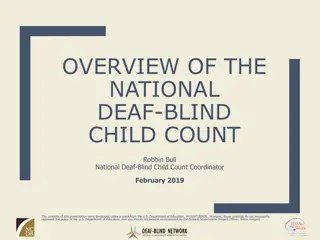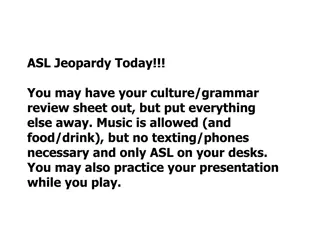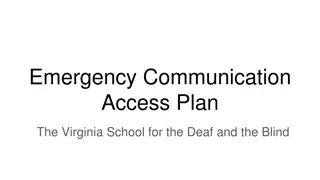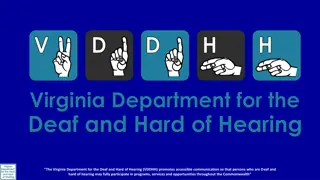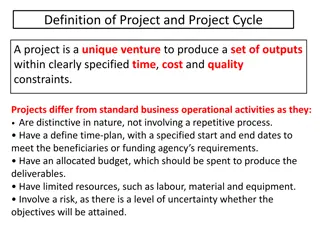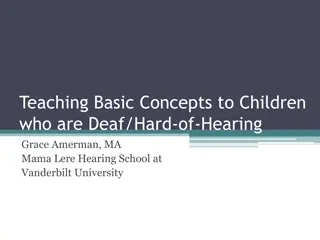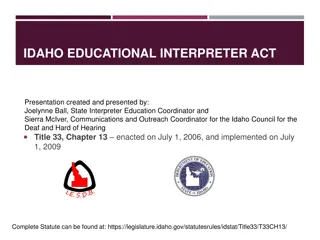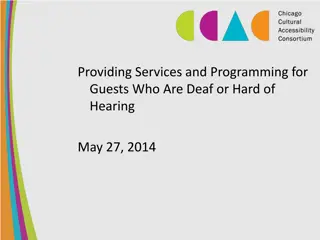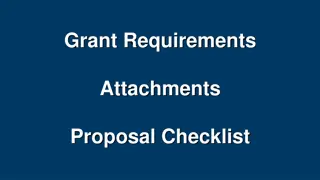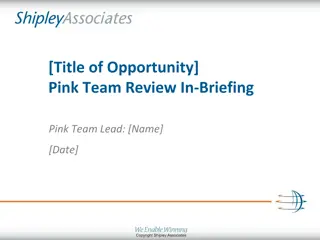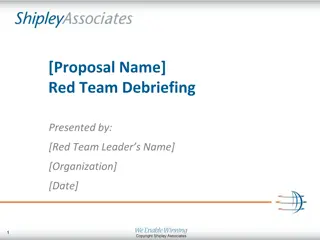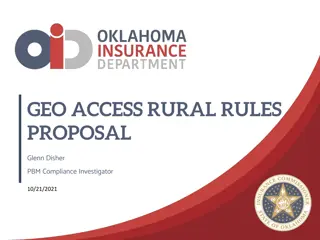Project Proposal for Jeevan Gnanodaya School for the Deaf
Jeevan Gnanodaya School for the Deaf, part of Jeevan Gnanodaya Charitable Trust, provides education, vocational training, and support to speech and hearing-impaired children from poor rural backgrounds. The project aims to offer formal education till Class 12, including speech therapy, and industrial training through their ITI program. The organization also runs a nursery and primary school for normal children. Various Asha chapters are involved in funding and supporting different aspects of the school's operations.
Download Presentation

Please find below an Image/Link to download the presentation.
The content on the website is provided AS IS for your information and personal use only. It may not be sold, licensed, or shared on other websites without obtaining consent from the author. Download presentation by click this link. If you encounter any issues during the download, it is possible that the publisher has removed the file from their server.
E N D
Presentation Transcript
Jeevan Gnanodaya Spring 2009 Proposal Project Website: http://www.ashanet.org/projects/project- view.php?p=84
Project Description Jeevan Gnanodaya School for the Deaf is a wing of the Jeevan Gnanodaya Charitable Trust. It has been functioning in Chengalpet since 1989. The school shelters and educates speech and hearing impaired kids from poor, rural backgrounds. When children are admitted their hearing level is determined and they are given the hearing aid equipment necessary for them. They are provided special speech therapy classes in addition to the regular curriculum. The school has also started an ITI for hearing-impaired children where they will acquire technical and industry-based skills like fitting, turning, carpentry etc. Some vocational skills like chalk making , tailoring are also being imparted to the children. All the facilities provided by the school are free, including food and lodging. They started with 5 students (in 1989) and the school now has 147 (~40 day scholars, rest hostel) students and classes up to X as of 2008. XI started this yr.
Purpose / Goals With their focus mainly on children with hearing disabilities, most of them (at least 90%) have profound hearing loss, the project's goals are mainly two-fold: * Provide formal education to children till Class 12, with necessary speech therapy along the way. Preference is given to students hailing from very poor families and to children who have profound hearing losses (meaning a hearing threshold of close to 90dB). * Industrial Training: Skills such as turning, fitting etc. -- achieved via the ITI. Since the ITI started, placement opportunities have become brighter, and students are getting reasonably good jobs.
Organization Description In addition to the school for the deaf, which Asha for Education is associated with, the trust also runs a nursery and primary school in Chengalpet (for "normal" children), helps with tuitions for slightly senior children. Secondary Focus: Vocational training Area: Rural Number of Children: 147 Number of Teachers: 16 School: 120, ITI: 27 Girl/Boy Ratio: School: 33:87 ITI: 3:24 Student/Teacher Ratio: 9 : 1 (Govt. Regulation 1:7) 18 can be accommodated for each yr of ITI
Asha's involvement with JG Seattle: Salaries for untrained teaching and non-teaching staff. This is a big component of their yearly budget. Cornell: Has funded them something small two years ago, and is not very active on the financial front now. However, they had submitted a proposal to WAH 2008, and so are still in touch with the project. Urbana-Champaign: Helped purchase new "behind the ear type" hearing aids for ITI students, and regular "pocket type" hearing aids for younger children in the first year. Funded the salaries of specially trained sign language instructors who are a recent addition at the school. The latter was actually a pretty in-depth learning effort between Asha-UC, and the project, and there was a collaboration with a professor from Gallaudet . A couple of professors from the university are going to be visiting JG in Sep/Oct later this year, and will be interning for 3 weeks or so. Atlanta: Funded partly the purchase of a van for Jeevan Gnanodaya, which was a critical need at that point of time. Others: Boston/MIT, Silicon Valley (Initial Proposal) No other NGO support all others are individual donors
Follow-Up Questions Q. How many students are there in the school? Q. What are the other NGO's who are supporting JG? Q. Who is supporting the marriage hall? Q. Do they have a corpus fund? Q. When was the last site visit? Q. Is this a one time proposal or should it be for multiple years?
Some recent student updates 2009 11thgrade added, to be followed by 12thin 2010. 14 wrote 10th, 1 failed. Rest passed. The 3 girls who passed -> 11th. Boys preferring to choose ITI (easier, more job opportunities quicker) 11th: Only accounts elective offered for now. Home visits started in Jan - March, as well as parents visit to school, 1hr a day. Last Site Visit: June 2008, Cornell Next site Visit: June and July 2009
Key Funding (from WAH 2008 Proposal) Asha for Education Salaries + other expense Monday charity club Food Lalitha Ramakrishna Note Books & Books P.S.SB Matriculation Chennai Uniforms, Hearing aid, Bathrooms Toilet Kalaimamani Pittukali Chennai- Food Mr. Dhanraj Chennai Educational materials Mrs. Jayashree Jaganathan & Mrs. Priya Ranganatha U.S.A- Hearing Aids Maintanance 3 Ladies Club in chennai For food Dr. Nirmala Muthaiyan Medical TN Govt - Food
Teachers at JG Till 2008, mostly self-trained, except for 3. 2008 - Hired 4 teachers, 3 with a B.Ed degree and 1 with a diploma; 3 female and 1 male teacher (Vivekananda University, Coimbatore) JG provides accommodation for all the lady teachers so they can stay nearby. All these teachers are specially trained to teach in sign language and also through regular speech therapy, lip movements, etc., and will be asked to handle the middle, higher classes in school along with the I.T.I. Also hired 3 teachers from a training institute in Kanyakumari, who were not trained to teach in sign language, but only in regular speech based techniques. These teachers will be assigned to primary classes (they are specially trained to handle younger children). All teachers equipped to teach Tamil and English. School: 6 trained, 7 untrained ITI: 3 Instructors, all male, +1 visiting instructor
Trained vs. Untrained teachers Untrained teachers have more experience with the students and know how to cover required portion at the appropriate pace, feel personally committed and willing to put in extra time/efforts. Trained teachers don t have experience with setting pace but are seeing progress due to SL knowledge. Treat JG as a workplace, look for better opportunities. Mrs Amruthavalli experienced teacher of 30 years, completed Level C, comes on Sundays to talk to all teachers, discuss new ideas, impart best practices, fine-tune teaching methods. Teaches additional speech techniques. Given some enumeration. Govt requires ~50% to be trained teachers Salary Trained: Rs. 6K + Benefits (Food, Accommodation, Travel) ~ Rs. 9K Untrained: Rs.4K - 5K L.I.C, welfare functions
Teaching Techniques (2007 2009) When a child gets admitted, a medical check up is done to determine the extent hearing loss, how many ears have gotten affected etc. and appropriate hearing aids are given. (Retained after child graduates) Then, they begin with helping the child try to make sounds this is hard, especially because some of the sounds need to be gotten out from the stomach, and communication with a deaf child is not easy. The younger the child is, easier it is for it to learn - practically impossible for children above 10 years of age. Then they try to teach the vowels, and alphabets, move on to more complex words(break them by the syllable). They re also taught to distinguish between several emotions, and other sounds which have very similar lip movements. Proper lip reading is taught by taking the aid of a mirror, and helping the child follow the teacher s lip movements on the mirror. Just this would take nearly a year (3 months to get the sound out and 9 months to teach letters and words) for a typical child. After this, the child enters 1st grade, where they begin to follow the regular TN state board syllabus. In each grade, before the class begins, the students are encouraged to speak amongst themselves the teachers ask them casual questions about what they did the previous day, what they ate etc., just so that they make an attempt to speak.
Sign Language No formal sign language based teaching was used. Mr. Devarajan was not even aware of the existence of one, or its advantages and disadvantages. Gestures (not to be confused with sign language) were used, nevertheless, whenever they are necessary. Students also typically resort to gesture based communication amongst themselves. Dr. Madan Vashishta (himself deaf), from the U.S Gallaudet University has been working with JG to inform them of the benefits of SL and ISL. 4 teachers hired who have completed Level A of ISL Training (Indian Sign Language) (There are different levels in sign language training A, B, C) It will however take about 2 years for the kids to complete the first level itself. Following that, JG will have to consider hiring experts to help them proceed further. (Increase salary, low retention rate) They've split classes into two sections 1 to 5 and 6 to 9. They are not teaching this to Class 10 currently. Grades 1-5 go at a slower pace than grades 6-9. They are doing the transition into sign language slowly so that kids don t lose ability to speak. No tests this year. Concern: Kids will lose motivation to speak. Signing considered as lazier option. So need to maintain a balance.
Issued faced by deaf children in getting into the Issued faced by deaf children in getting into the mainstream : mainstream : If treated well, no major problems with socializing. Most problems purely due to the communication problem that arises because of their speech and hearing handicap frustration due to glitches in smooth communication and this usually takes a turn for the worse. Also, if there are too many deaf children at the same place (in a work environment), they tend to form a group and cause problems. (There have been some unpleasant experiences with a company where a group of deaf workers formed a union and created trouble.) Few companies come voluntarily to give jobs to the deaf. Ones that do come forth due to sympathy factory. Companies prefer high-end deaf schools that offer better training. (Balavidyalaya, CSI School for the Deaf, Clarke School for the Deaf) Most jobs require relocation and a local guardian so most students take jobs in and around Chengalpet. Parental involvement is very minimal. JG keeps in touch with graduated students, contact them 3 times/yr.
Government Funding Mainly for food under a scheme for schools with hostels called Maintenance Grant. Help cover expense of about 30% of the children in the age group 6-16 yrs. Amount of money from the government is about Rs. 50,000. There is no government support in terms of books etc. He has been getting this grant for the last 7 years now, but is doubtful this year because it is election year. Plans for self-sustainability Marriage Hall currently being constructed expected to be finished by the end of the year. By 2012, JG expected to stand on its own feet, assuming no other issues arise. 65 muhurtams/yr + 15 other events = 80 events 10 lakhs or so expected every month and should help cover running expenses pretty easily, only building tax needs to be paid. ITI Factory expected to raise income by 2011. Plan to use some of the money as a fixed deposit to generate interest.
Asha Austin Proposal 2009-2019 School Yr Educational Materials New, not supported before. For 109 students, as anticipated in Feb. Rest will be covered by JG. Don t expect > 150 students
Back-Up Today's Hearing Classification Hearing Threshold Normal hearing -10 to 15 dB Slight hearing loss 16 to 25 dB Mild hearing loss 26 to 40 dB Moderate hearing loss 41 to 55 dB Moderately severe loss 56 to 70 dB Severe hearing loss 71 to 90 dB Profound hearing loss 91 to 120 dB Deaf below 120 dB





